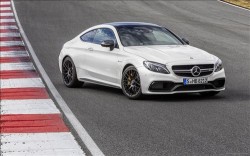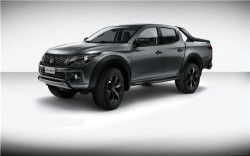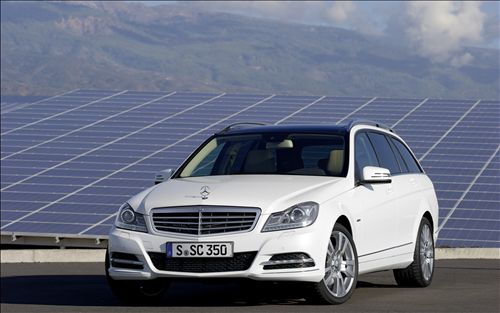-
Energetic: new, dynamic appearance inside and out
-
Extended: ten new assistance systems for more safety
-
Efficient: new engines with up to 31 percent lower fuel consumption
-
Experience: new generation of telematics with internet access
-
Successful: more than one million units of the current series
sold since March 2007
The new C-Class to be launched in spring 2011 is a comprehensive modernisation. The front and rear sections of this bestselling model have a more striking design. Together with the optional, high-resolution colour display in the instrument cluster, the new dashboard with its elegant, grained surface and prominent decorative trim emphasises the premium character of the interior. Fuel consumption has been lowered by up to 31 percent. Efficiency-enhancing measures include new engines, the improved 7G-TRONIC PLUS automatic transmission and the ECO start/stop function. Ten new driving assistance systems ranging from ATTENTION ASSIST drowsiness detection to DISTRONIC PLUS proximity control are now available for this model series. The new-generation telematics include internet access and a 3D navigation display with plastic city views.
"In terms of drive and protection systems the new-generation C-Class offers the same comfort and safety as our luxury models. And with numerous high-grade features in the interior that remind one of the new CLS, the C-Class sets completely new standards in its segment with respect to perceived value and quality," says Dr. Joachim Schmidt, Sales & Marketing Director at Mercedes-Benz Cars. This interior modernisation is supplemented with a new telematics generation that not only includes completely redesigned displays, but also makes onboard internet access available.
A total of more than 2000 new components distinguish the latest generation of the Mercedes-Benz C-Class from its predecessor. Both the Saloon and Estate versions can be ordered from 10 January 2011. The European market launch will take place from March 2011. In addition to the standard appointments – which now include a leather steering wheel – the two design and equipment lines ELEGANCE and AVANTGARDE are the basis for the individualisation programme of the C-Class. The two lines are now even more readily distinguishable from each other.
The C-Class is the highest-selling model series, and therefore of particular importance for Mercedes-Benz. The current series has found well over one million buyers worldwide since its launch in March 2007. Since the introduction of the first C-Class in 1982 (then known as the model 190), Mercedes-Benz has sold more than 8.5 million vehicles in total in this segment. In 2010 too, the C-Class has repeatedly won top places in the registration statistics.
Dynamic, resolute, self-assured: the exterior
The front bumper has a more expressive and dynamic contours, the front section being brought closer to the brand's new design idiom. This starts with a more prominent radiator grille surround. The central air intake opens out upwards in a V-shape, forming a visual base unit for the radiator grille. Pronounced side sections extend from the sporty V-shape at the centre of the bumper. Continuing beneath the headlamps, these sections blend into the feature lines along the vehicle flanks, linking the front section with the sides. The side air inlets in the bumper are positioned low down, giving the car a more road-hugging appearance.
The Saloon and Estate now have a new aluminium bonnet, which contributes to weight reduction and therefore fuel efficiency. Its contour in the area of the headlamps and radiator grille emphasises the V-shape of the front section more heavily than before. In conjunction with the newly designed headlamps, this gives the front section a more resolute impression.
The shape of the clear-lens headlamps has been modified to create a more dynamic and resolute impression, and to act together with the bonnet, radiator grille and bumper to emphasise the V-shape of the front section. This impression is reinforced by both the exterior form of the headlamps and the interior of the housings. The headlamps show their modernity by precision and an interplay between matt and high-sheen areas. The halogen headlamps are arranged in the classic way, with low beam on the outside, high beam on the inside and the indicators neatly arranged in the outer corner formed with the front wing.
If the optional bi-xenon headlamps with the Intelligent Light System (ILS) are specified, the impression of depth is reinforced by a row of lighting modules. A position light with a distinctive C-shape emphasises the night design. Behind it is a cornering light extending to the main headlamp module on the outside. All three levels are connected by a transverse strip extending through the complete headlamp interior with dark contrasts, shiny areas and matt areas. A visual base in the lower section of the headlamp is formed by a horizontal broadband LED indicator unit. The horizontal LED daytime running lamps in the bumper also make the C-Class unmistakable from a distance.
In the case of the rear bumper, the light-catching contours and dividing lines have been modified to emphasise the width of the Saloon and Estate even more strongly. This change is particularly obvious in the more steeply rising course of the side light-catching contours towards the tail lights. A continuous light-catching contour at the upper end of the rear bumper extends into the flanks to connect the rear end with the sides to emphasise the sporty character of the rear aspect. In the facelifted model, the tail lights are even more neatly integrated into the rear section by a continuous covering lens. The characteristic surface meander is now on the inside of the light, and reminiscent of preceding model series. The particular impression of depth is achieved by a centrally located LED indicator, which appears to float in front of the red upper and lower light bands with their more deeply set LEDs. The tail lights have a particularly high recognition factor in the dark.
The aerodynamics of the C-Class are the mark of the bodyshell's efficiency. With a Cd figure of 0.26 it not only sets the benchmark in its class, but also glides through the wind better than most compact cars with its drag area of Cd x A = 0.57 sq. m.
Sporty, high-quality interior
The main focus of the design work in the interior was on restyling the dashboard with its integrated screen and new surface grain. The touch surfaces of the controls are now also more finely detailed and galvanised. A stepped extension to the instrument cluster now also accommodates the central display. The instrument cluster and a discreet light-catching contour continue into the front passenger side. The central, trapezoidal air vents and the round vents on the outside are highlighted in detail by galvanised trim.
The large section of trim is an important part of the newly designed dashboard. This extends from the centre air vents across the front passenger side to the outer air vent, while the lower edge of the upper dashboard section continues into the beltlines of the door panels with a new surface grain.
The control panel of the new-generation communication and information unit has keys with high-gloss surface inserts. The combination of keys, high-gloss areas and a new knurled wheel design accentuates the higher perceived value of the interior. In conjunction with the new telematics generation, the facelifted C-Class is also available with an optional, high-resolution colour display in the instrument cluster.
The premium character of the interior is underlined by the new-generation steering wheel, which was introduced with the new CLS and is now available in the sporty AVANTGARDE line for the C-Class. The steering wheel with its chromed central spoke stylishly accentuates the sporty atmosphere in the C‑Class.
The ELEGANCE and AVANTGARDE lines are more readily distinguishable from each other. This has been partly achieved by new trim in matt ash wood or walnut (ELEGANCE), or dark aluminium or black ash wood (AVANTGARDE). Stand features in the ELEGANCE line include luxury head restraints whose side bolsters can be adjusted as required.
More power, lower consumption: the engines
A reduction of up to 31 percent has been achieved in fuel consumption. All the rear-wheel drive C-Class models are equipped with the ECO start/stop function as standard. All the engine variants are now classed as BlueEFFICIENCY units, showing that they are particularly efficient and environmentally compatible in their use of fuel. In future all automatic versions with the exception of the C 300 CDI 4MATIC will feature the further-developed 7G-TRONIC PLUS seven-speed automatic transmission (introduction in the C 250 CDI 4MATIC in June 2011). In addition, the overall ratio of all new powertrain variants has been optimised for fuel economy.
All the petrol engines in the model series have direct injection. One of the highlights is the introduction of the new V6 petrol engine with its innovative and highly efficient BlueDIRECT process in the C 350 BlueEFFICIENCY. The quantum leap in efficiency is particularly well illustrated by the six-cylinder unit: Power has increased considerably, the C 350 BlueEFFICIENCY delivering 225 kW (306 hp) and 370 Nm (previously 215 kW/292 hp and 365 Nm). Fuel consumption has been significantly reduced, however: the C 350 BlueEFFICIENCY has a mean consumption of 6.8 litres per 100 km – 1.5 litres or 31 percent less than the preceding C 350 model. [1]
The four-cylinder petrol engines, which made a great evolutionary leap forward in 2009 and all feature direct injection and turbocharging, excel with high performance and exemplary economy.
All C-Class petrol models at a glance [2]
|
Model*
|
Cyl.
|
cc
|
kW/hp at rpm
|
Nm from rpm
|
0-100 km/h (s)
|
Top speed km/h
|
l/100 km NEDC comb.
|
CO2 g/km
|
|
C 180 BE
|
4/in-line
|
1796
|
115/156 5000
|
250 1600
|
8.9 (9.0)
|
223 (225)
|
6.4-6.9 (6.7-7.3)
|
148-160 (157-169)
|
|
C 200 BE
|
4/in-line
|
1796
|
135/184 5250
|
270 1800
|
7.8 (8.2)
|
235 (237)
|
6.4-6.9 (6.6-7.2)
|
150-161 (154-168)
|
|
C 250 BE
|
4/in-line
|
1796
|
150/204 5500
|
310 2000
|
7.2
|
240
|
6.4-6.9
|
150-161
|
|
C 350 BE
|
V6
|
3498
|
225/306 6500
|
370 3500
|
6.0
|
250
|
6.8-7.0
|
159-164
|
|
C 350 4MATIC BE
|
V6
|
3498
|
225/306 6500
|
370 3500
|
6.0
|
250
|
7.4-7.6
|
174-178
|
BE = BlueEFFICIENCY, * figures for automatic transmission, manual transmission in brackets
The most economical model in the Mercedes C-Class has also become even more frugal: the C 220 CDI BlueEFFICIENCY with the manual six-speed transmission and the standard ECO start/stop function has a mean diesel consumption of 4.4 litres per 100 km – 0.4 litres less than before. This corresponds to 117 grams of CO2 per kilometre. In conjunction with the improved 7G-TRONIC PLUS automatic transmission and the ECO start/stop function included as standard, the C 220 CDI BlueEFFICIENCY and C 250 CDI BlueEFFICIENCY both deliver top-class figures with a combined diesel consumption of just 4.8 litres per 100 km. This corresponds to CO2 emissions of 125 grams per kilometre.
All C-Class diesel models at a glance2
|
Model*
|
Cyl.
|
cc
|
kW/hp at rpm
|
Nm from rpm
|
0-100 km/h (s)
|
Top speed km/h
|
l/100 km NEDC comb.
|
CO2 g/km
|
|
C 180 CDI BE
|
4/in-line
|
2143
|
88/120 2800
|
300 1400
|
10.8 (10.5)
|
206 (208)
|
4.9-5.3 (4.8-5.3)
|
129-140 (125-139)
|
|
C 200 CDI BE
|
4/in-line
|
2143
|
100/136 2800
|
360 1600
|
9,1 (9.2)
|
215 (218)
|
4.9-5.3 (4.8-5.3)
|
129-140 (125-139)
|
|
C 220 CDI BE
|
4/in-line
|
2143
|
125/170 3000
|
400 1400
|
8.1 (8.4)
|
231 (232)
|
4.8-5.2 (4.4-5.1)
|
125-136 (117-133)
|
|
C 250 CDI BE
|
4/in-line
|
2143
|
150/204 4200
|
500 1600
|
7.1
|
240
|
4.8-5.2 (4.8-5.3)
|
125-136 (125-140)
|
|
C 250 CDI 4MATIC BE
|
4/in-line
|
2143
|
150 (204)
|
500 1600
|
7.1
|
240
|
5.4-5.7
|
144-152
|
|
C 300 CDI 4MATIC BE
|
V6
|
2987
|
170/231 3800
|
540 1600
|
6.4
|
250
|
7.0-7.2
|
185-189
|
BE = BlueEFFICIENCY, * figures for automatic transmission, manual transmission in brackets
Warning and intervening: the new driving assistance systems
With a total of ten new driving assistance systems ranging from ATTENTION ASSIST drowsiness detection to DISTRONIC PLUS proximity control, the C-Class reaches a new level in safety. The assistance systems are based on the latest radar, camera and sensor technology, and cover frequent accident causes such as driving too closely, fatigue and darkness. The new assistance systems, some of which only warn and some which actively intervene in hazardous situations, at a glance:
More operating comfort, better connectivity: new-generation telematics
The new C-Class also sees the debut of a new telematics generation which will also be gradually introduced in other model series. Major new features include greater operating convenience, larger displays, telephone directory transfer, display of SMS messages, wireless music reproduction via Bluetooth and a USB interface now accommodated in the centre armrest.
The multimedia system COMAND Online now provides internet access for the first time. When the car is stationary, customers are able to browse freely or surf to a Mercedes-Benz Online service whose pages load particularly rapidly and are also easy to use while on the move. The integrated services include weather information and a special destination search via Google, as well as the option of downloading a route that has been previously configured on a PC using Google Maps and sent to the car. The navigation system of COMAND Online also has added functions. New features include a 3D display with plastic city views. Also new: routes covered can be recorded and repeated later, specific personal destinations can be imported via an SD card and four alternative routes can be displayed on the navigation map, one of them a particularly economical variation.































































































